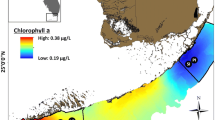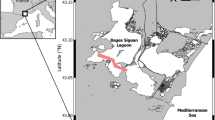Abstract
The effects of El Niño (EN) and La Niña (LN) events upon marine organisms inhabiting the Eastern Pacific coast have been widely studied in recent years, concentrating primarily on changes in species composition and on population size. In this study, using somatic growth rates as metabolic response variables, we evaluated the mortality rates of coastal fishes inhabiting a central Chilean upwelling marine ecosystem in the South Pacific between 1990 and 2003. Four coastal fish species belonging to different trophic levels (one herbivore, one omnivore, and two carnivores) were analyzed. In all species, the estimated cohort somatic growth rates were low for those recruited during EN and high for those recruited during LN events. Annual cohort mortality rates were highest during EN events and lower during LN and transitional years. We propose that productivity (as a bottom-up driver) acts as a primary exogenous factor upon annual cohort mortality rates. We also propose that a plausible mechanism underlying this process is the negative effect the low somatic growth rates may have on fish ecological attributes such as their competitive abilities, condition factors, and predation risks, which ultimately may affect their fitness.









Similar content being viewed by others
References
Arcos D, Cubillos L, Nuñez S (2001) The jack mackerel fishery and El Niño 1997–98 effects off Chile. Prog Oceanogr 49:597–617
Arntz W, Fahrbach E (1996) El Niño: experimento climático de la naturaleza. Fondo de Cultura Económica., México
Attrill M, Power M (2002) Climatic influence on a marine fish assemblage. Nature 417:275–278
Boersma P (1998) Population trends of the Galápagos Penguin: impacts of El Niño and La Niña. Condor 100:245–253
Calow P (1985) Adaptive aspects of energy allocation. In: Tyler P, Calow P (eds) Fish energetics new perspectives. Sydney, Australia, pp 349
Castilla JC , Camus PA (1992) The Humboldt-El Niño scenario: coastal benthic resources and anthropogenic influences, with particular reference to the 1982/83 ENSO. South African J mar sci 12:703–712
Chavez FP, Strutton PG, Friederich GE, Feely RA, Feldman GC, Foley DG, McPhaden MJ (1999) Biological and chemical response of the equatorial Pacific Ocean to the 1997–98 El Niño. Science 286:2126–2131
Chavez FP, Pennington JT, Castro CG, Ryan JP, Michisaki RP, Schlining B, Walz P, Buck KR, McFayden CA (2002) Biological and chemical consequences of the 1997–98 El Niño in central California waters. Prog Oceanogr 54:205–237
Chavez FP, Ryan J, Lluch S, Ñiquen M (2003) From anchovies to sardines and back: multidecadal change in the Pacific Ocean. Science 229:217–221
Davis JL (2000) Changes in tidepool fish assemblages on two scales of environmental variation: seasonal and El Niño Southern Oscillation. Limnol Oceanogr 45:1368–1379
Fiedler PC (2002) Environmental change in the eastern tropical Pacific Ocean: review of ENSO and decadal variability. Mar Ecol Prog Ser 244:265–283
Fonseca TR, Farias M (1987) Estudio del proceso de surgencia en la costa chilena utilizando percepción remota. Invest Pesquera (Chile) 34:33–46
Gayanilo FC Jr, Pauly D (eds) (1997) The FAO-ICLARM stock assessment tools (FiSAT) reference manual. FAO computerized information series (Fisheries), vol 8, FAO, Rome, p 262
Godínez-Domínguez E, Rojo-Vásquez J, Galván-Piña V, Aguilar-Palomino B (2000) Changes in the structure of a coastal fish assemblage exploited by a small scale gillnet fishery during an El Niño-La Niña event. Estuar Coast Shelf Sci 51:773–787
Gulland JA, Holt SJ (1959) Estimation of growth parameters for data at unequal time intervals. J Cons CIEM 25(1):47–49
Hayward T (1997) Pacific Ocean climate change: atmospheric forcing, ocean circulation and ecosystem response. Tree 12:150–154
Heino M, Kaitala V (1999) Evolution of resource allocation between growth and reproduction in animals with indeterminate growth. J Evol Biol 12:423–429
Hernández CE, Neil P, Pulgar J, Ojeda FP, Bozinovic F (2002) Water temperature fluctuations and territoriality in the intertidal zone: two possible explanations for the elevational distribution of body size in Graus nigra. J Fish Biol 61:472–488
Hernández-Miranda E (2006) Demografía de peces costeros residentes en un ecosistema de surgencias: efecto de factores endógenos y exógenos en su dinámica espacio-temporal. Ph.D. Thesis. Universidad Católica de Chile. Center for Advances Studies in Ecology and Biodiversity (CASEB) Chile
Hernández-Miranda E, Palma AT, Ojeda FP (2003) Larval fish assemblages in nearshore coastal waters off Central Chile: temporal and spatial patterns. Estuar Coast Shelf Sci 56:1075–1092
Hoyos L, Tarazona J, Siga B, Chiong V (1985). Algunos cambios en la ictiofauna y sus relaciones tróficas durante el fenómeno El Niño en la bahía de Ancón. Boletín Volumen Extraordinario. Instituto del Mar del Perú. Simposio El Niño su impacto en la fauna marina
Iriarte JL, González HE (2004) Phytoplankton size structure during and after the 1997/98 El Niño in a coastal upwelling area of the northern Humboldt Current System. Mar Ecol Prog Ser 269:83–90
Jaksic FM (2001) Ecological effects of El Niño in terretrial ecosystems of western South America. Ecography 24:241–250
Kristjánsson JE, Staple A, Kristiansen J, Kaas E (2002) A new look at possible connections between solar activity, clouds and climate. Geophysical Research Letters 29:22 1–4
Lima M (2001) The dynamics of natural populations: feedback structures in fluctuating environments. Rev Chil Hist Nat 74:317–329
Massey BW, Bradley DW, Atwood JL (1992) Demography of a California tern colony including effects of the 1982–83 El Niño. Condor 94:976–983
McPhaden MJ (1999) Genesis and evolution of the 1997–1998 El Niño. Science 283:950–954
Meekan MG, Wellington GM, Axe L (1999) El Niño-Southern Oscillation events produce checks in the otoliths of coral reef fishes in the Galápagos archipelago. Bull Mar Sci 64:383–390
Menge BA (1992) Community regulation: under what conditions are bottom-up factors important on rocky shores?. Ecology 73:755–765
Michalsen K, Ottersen G, Nakken O (1998) Growth of north-east cod (Gadus morhua L.) in relation to ambient temperature. ICES J Mar Sci 55:863–877
Muñoz A, Ojeda FP (1997) Feeding guild structure of a rocky intertidal fish assemblage in central Chile. Environ Biol Fishes 49:471–479
Muñoz A, Ojeda FP (1998) Guild structure of carnivorous intertidal fishes of the Chilean coast: implications of ontogenetic dietary shifts. Oecologia 114:563–573
Muñoz A, Ojeda FP (2000) Ontogenetic changes in the diet of the herbivorous Scartichthys viridis in a rocky intertidal zone in central Chile. J Fish Biol 5:986–998
Nielsen KJ, Navarrete SA (2004) Mesoscales regulation comes from the bottom-up: intertidal interactions between consumers and upwelling. Ecol Lett 7:31–41
Null J (2004) El Niño & La Niña Years: a consensus list. http://www.ggweather.com/enso/years.htm
Ojeda FP Muñoz A (1999) Feeding selectivity of the herbivorous fish Scartichthys viridis: effects on macroalgal community structure in a temperate rocky intertidal coastal zone. Mar Ecol Prog Ser 184:219–229
Ottersen G, Helle K, Bogstad B (2002) Do abiotic mechanisms determine interannual variability in length-at-age of juvenile Arcto-Norwegian cod?. Can J Fish Aqua Sci 59:57–65
Quenouille MH (1952) Associated measurement. Butterworth-Heinemann Ltd., London
Quijada PA, Cáceres CW (2000) Patrones de abundancia, composición trófica y distribución espacial del ensamble de peces intermareales de la zona centro-sur de Chile. Rev Chil Hist Nat 73:739–747
Riascos JM (2002) Changes in the macrobenthos of a sandy beach during “El Niño” 1997–98 in the Malaga Bay. Colombian Pacific. Ciencias Marinas 28(1):13–25
Soto R (1985) Efectos del Fenómeno El Niño 1982-83 en ecosistemas de la I Región. Invest Pesqueras (Chile) 32:199–206
Stenseth N, Mysterud A, Ottersen G, Hurrel J, Chan K, Lima M (2002) Ecological effects of climate fluctuations. Science 297:1292–1296
Strub PT, Mesías JM, Montecino V, Rutllant J, Salinas S (1998) Coastal ocean circulation off western South America. In: Robinson AR, Brink KH (eds) The sea, vol 11. Wiley, New York, pp 273–313
Thomas A, Carr M, Strub P (2001) Chlorophyll variability in eastern boundary currents. Geophys Res Lett 28:3421–3424
Tomicic J (1985) Efectos del Fenómeno El Niño 1982-83 en las comunidades Litorales de la Península de Mejillones. Invest Pesqueras (Chile) 32:209–213
Tsai C-F, Chen P-Y, Chen C-P, Lee M-A, Shiah G-Y, Lee K-T (1997) Fluctuation in abundance of larval anchovy and environmental conditions in coastal waters off south-western Taiwan as associated with the El Niño-Southern Oscillation. Fish Oceanogr 6:238–249
Varas E, Ojeda FP (1990) Intertidal fish assemblages of the central Chilean coast: diversity, abundante and trophic patterns. Revista de Biología Marina, Valparaíso 25:59–70
Walther G, Post E, Convey P, Menzel A, Parmesan C, Beebee T, Fromentin J, Hoegh-Guldberg O, Bairlein F (2002) Ecological responses to recent climate change. Nature 416:389–395
Wang H, Zhang R, Cole J, Chavez FP (1999) El Niño and the related phenomenon southern oscillation (ENSO): The largest signal in interannual climate variation. Proc Natl Acad Sci USA 96:11071–11072
Wieters E, Kaplan D, Navarrete S, Sotomayor A, Largier J, Nielsen K, Véliz F (2003) Alongshore and temporal variability in chlorophyll a concentration in Chilean nearshore waters. Mar Ecol Prog Ser 249:93–105
Willette TM, Cooney RT, Hyer K (1999) Predator foraging mode shifts affecting mortality of juvenile fishes during the subarctic spring bloom. Can J Fish Aquat Sci 56:364–376
Wikelski M, Carrillo V, Trillmich F (1997) Energy limits to body size in a grazing reptile, the Galapagos marine iguana. Ecology 78:2204–2217
Woodbury D (1999) Reduction of growth in otholiths of widow and yellowtail rockfish (Sebastes entomelas and S. flavidus) during the 1983 El Niño. Fish Bull US 97:680–689
Acknowledgements
We thank A. Angel, C. Hernández, F. Labra, V. Lobos, F. Ogalde, J. Pulgar, and P. Quijada for their important support during field work. Thanks also to J. M. Fariña, F. Jaksic, A. Muñoz, G. Owen, E. Poulin, and N. C. Stenseth for their constructive comments, and to A. Thomas for satellite data. SST data was kindly provided by ECIM and SHOA. This study was funded by FONDECYT grants 1960254 and 1990154, and FONDAP-FONDECYT grant 1501-0001 to FPO. E. Hernández-Miranda is currently supported by a CONICYT Doctoral Fellowship and Apoyo de Tesis Doctoral.
Author information
Authors and Affiliations
Corresponding author
Additional information
Communicated by O. Kinne, Oldendorf/Luhe
Rights and permissions
About this article
Cite this article
Hernández-Miranda, E., Ojeda, F.P. Inter-annual variability in somatic growth rates and mortality of coastal fishes off central Chile: an ENSO driven process?. Mar Biol 149, 925–936 (2006). https://doi.org/10.1007/s00227-006-0249-9
Received:
Accepted:
Published:
Issue Date:
DOI: https://doi.org/10.1007/s00227-006-0249-9




